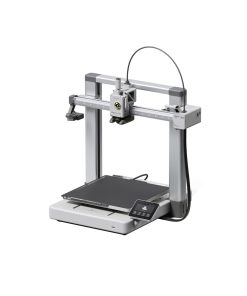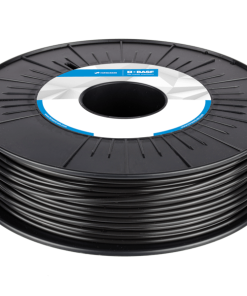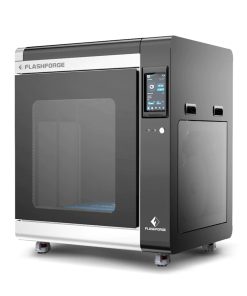Polymaker PolySonic PLA Pro – White Polymaker
$ 29,99 $ 17,99
Polymaker PolySonic PLA Pro, 1.75MM, 1KG – White
Your Projects, FASTER!
PolySonic™ PLA Pro is a tough PLA that can print at incredible speeds. With its advanced formulation, this filament ensures durable, rugged prints, with an impact strength similar to ABS and bending strength outperforming ASA & PETG. When time is of the essence for functional parts, PolySonic™ PLA Pro is the ideal choice for you.
What is a High Speed filament?
A material is considered “High Speed” if it fulfills the following 3 criteria at a set printing temperature:
- Flowability: It can extrude consistently at 24mm3/s on popular extrusion system. (equivalent to 300mm/s at 0.2mm layer height with a 0.4mm nozzle)
- Formability: At 24mm3/s, it maintains similar surface quality, overhang and bridging as printed at lower speed.
- Functionality: At 24mm3/s, it maintains at least 80% of its overall mechanical properties when printing at lower speed. (mainly: layer adhesion, tensile strength and impact strength)
PolySonic™ PLA at 230˚C
- Maximum flow*: 29mm3/s** (tested on a customized extrusion platform equipped with an E3D volcano hotend, 0.4mm nozzle with Hemera XS extruder)
- Confirmed similar quality Polymaker Scientist when printed at 4mm3/s and 24mm3/s
- Layer Adhesion at 4mm3/s-24mm3/s: 37.3-32.3 MPa (Maintain 87%)
Tensile Strength at 4mm3/s-24mm3/s: 46.0-43.9 (Maintain 95%)
Impact strength at 4mm3/s-24mm3/s: 6.1-5 kJ/m2 (Maintain 82%)* Maximum Flow: Flow at which the measured flow is decreasing below 95% of the requested flow.
** For 0.2mm layer height with 0.4mm nozzle: 29mm3/s -> 363mm/s
For 0.1mm layer height with 0.4mm nozzle: 29mm3/s -> 725mm/s
What are the advantages of using a High Speed filament?
- Surface Quality at high speed:
When printing at high speed, the nozzle will actually experience a wide variety of speed going from 0mm/s to the max speed set on the slicer. The higher the max speed, the wider the range of different speeds. The issue is with the printing temperature being the same, the extrusion temperature will vary dramatically leaving difference surface finishes on the print (from glossy to matte because of a phenomenon called: Shark Skin), High Speed filament reduces these differences by displaying similar surface finish in a wide range of flow rates.
Additionally, high speed filament will extrude much more consistently within the speed range providing a smooth surface whereas regular filament will display holes, artifacts and layers with different thicknesses.
- Mechanical Properties at high speed:
High Speed filament will display far greater overall mechanical properties when printed at higher speed than regular filament because of the more consistent extrusion and the optimized cooling/melting rate of the polymer.
- Higher Throughput:
Thanks to 1) and 2), you are able to output the same quality part at a much higher pace from your 3D printer. This advantage is ideal for businesses using 3D printing to produce their products.
Printing and Drying Settings?
Printing Temperature:
Classic: 190˚C – 230˚C
High Speed: 210˚C-230˚C
Printing Speed:
Classic: 50mm/s – 100mm/s
High Speed: 100mm/s – 300mm/s
Bed Temperature: 25˚C – 60˚C
Fan: ON
Direct Drive:
Retraction Distance: 1mm
Retraction Speed: 20mm/s
Indirect Drive:
Retraction Distance: 3mm
Retraction Speed: 40mm/s
Drying Settings: 55˚C for 6h
(Only if the material has absorbed moisture)
Spool Dimensions?
1kg cardboard spool:
Spool Inner Hole Diameter: 55±1mm
Spool Diameter: 200±1mm
Spool Width: 65.6±2mm
Spool Weight: 140±7g
Professional packing and fast shipping
Due to our longstanding partnership with UPS FedEx DHL and other major global carriers, we are able provide a range of shipping options. Our warehouse staff is highly trained to package your goods exactly as per the specifications we offer. Before shipping the goods are carefully inspected and secured. Everyday we deliver thousands of packages to customers from all over the world. This is a testament to our commitment to be the largest online retailer worldwide. The warehouses and centers for distribution are situated in Europe and the USA.
Orders with more than one item are given processing time for each item.
Before shipping, we will conduct a thorough inspection of the items you've ordered. Currently, most orders are shipped within 48-hours. Expected delivery time is between 3 and 7 days.
Returns
The stock is dynamic and we do not fully manage it because of the fact that multiple stakeholders are involved, including our factory and warehouse. The actual levels of stock can change at any moment. It's possible that the stock may run out after your order has been placed.
The policy is 30 days. If you haven't received the product within 30 days, we are not able to issue a refund or an exchange.
For your item to be returned, it must be unopened and in the same state as you received it in. It must also be in the original packaging.
Related products
3D Printer
3D Printer
3D Printer
3D Printer
3D Printer
3D Printer
























































